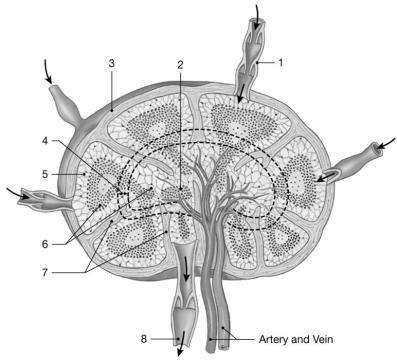A) has one constant segment
B) has one variable segment
C) binds one light chain
D) binds antigen at both ends
E) binds complement in the constant region
G) C) and E)
Correct Answer

verified
Correct Answer
verified
Multiple Choice
When an antigen is bound to a Class II MHC protein,it can activate a ________ cell.
A) plasma
B) helper T
C) NK
D) suppressor T
E) cytotoxic T
G) D) and E)
Correct Answer

verified
Correct Answer
verified
Multiple Choice
Lymphocytes provide an adaptive or specific defense known as the
A) phagocytic response.
B) adaptive defense.
C) immune response.
D) lymphocytic response.
E) inflammation of tissues.
G) A) and E)
Correct Answer

verified
Correct Answer
verified
Multiple Choice
Inappropriate or excessive immune responses to antigens are
A) immunodeficiency diseases.
B) autoimmune diseases.
C) allergies.
D) the result of stress.
E) signs of a weak immune system.
G) A) and C)
Correct Answer

verified
Correct Answer
verified
Multiple Choice
Class II MHC proteins are present in the plasma membrane only
A) when plasma cells are releasing antibodies.
B) in antigen-presenting cells and lymphocytes.
C) when cytotoxic T cells are inhibited.
D) when NK cells are activated.
E) during infections.
G) All of the above
Correct Answer

verified
Correct Answer
verified
Multiple Choice
Innate defenses include
A) phagocytic cells.
B) physical barriers.
C) inflammation.
D) interferons.
E) All of the answers are correct.
G) A) and E)
Correct Answer

verified
Correct Answer
verified
Multiple Choice
Antigens that trigger allergic reactions are called
A) interferons.
B) microbes.
C) pyrogens.
D) allergens.
E) agglutinins.
G) C) and D)
Correct Answer

verified
Correct Answer
verified
Multiple Choice
The various classes of immunoglobulins are differentiated on the basis of their
A) asymmetry.
B) antigen specificity.
C) light-chain variable segments.
D) heavy-chain constant segments.
E) reactivity.
G) A) and D)
Correct Answer

verified
Correct Answer
verified
Multiple Choice
Antigen-presenting cells located in the epithelia of the skin are called
A) keratinocytes.
B) squamous macrophages.
C) germinative cells.
D) dendritic cells.
E) Merkel cells.
G) A) and C)
Correct Answer

verified
Correct Answer
verified
Multiple Choice
When an antibody binds to its specific antigen a(n) ________ is formed.
A) phagocytic unit
B) agglutination system
C) antibody-antigen complex
D) hemolytic setting
E) co-stimulation region
G) A) and E)
Correct Answer

verified
Correct Answer
verified
Essay
List and briefly describe the four general properties of immunity.
Correct Answer

verified
(1)Specificity: The immune response is t...View Answer
Show Answer
Correct Answer
verified
View Answer
Multiple Choice
When the immune response mistakenly targets normal body cells and tissues,a(n) ________ develops.
A) autoimmune disease
B) immunodeficiency disease
C) allergic response
D) cross-reaction
E) agglutination reaction
G) A) and B)
Correct Answer

verified
Correct Answer
verified
Multiple Choice
Cytokines that make a cell and its neighbors resistant to virus infection are called
A) complement.
B) interferons.
C) interleukins.
D) immunoglobulins.
E) transferrins.
G) A) and D)
Correct Answer

verified
Correct Answer
verified
Multiple Choice
Interleukins do all of the following except
A) increase T-cell sensitivity to antigens exposed on macrophage membranes.
B) stimulate B-cell activity,plasma cell formation,and antibody production.
C) stimulate inflammation.
D) elevate body temperature.
E) stimulate collagen synthesis.
G) B) and D)
Correct Answer

verified
Correct Answer
verified
Multiple Choice
In passive immunity,the
A) immune system attacks normal body cells.
B) body is deliberately exposed to an antigen.
C) body receives antibodies produced by other humans.
D) body receives antibodies produced by an animal.
E) body receives antibodies produced by other humans or by an animal.
G) D) and E)
Correct Answer

verified
Correct Answer
verified
Multiple Choice
In a(n) ________,either the immune system fails to develop normally or the immune response is blocked.
A) autoimmune disease
B) immunodeficiency disease
C) allergic response
D) cross-reaction
E) agglutination reaction
G) All of the above
Correct Answer

verified
Correct Answer
verified
Multiple Choice
T is to ________ as B is to ________.
A) top-located; bottom-located
B) thymus-dependent; bone marrow-derived
C) thyroid-drawn; bowel-developed
D) non-thymus-dependent; bottom-located
E) trabeculae-descended; bursa-origin
G) A) and D)
Correct Answer

verified
Correct Answer
verified
Multiple Choice
 Figure 22-1 The Structure of a Lymph Node
Use Figure 22-1 to answer the following questions:
-Identify the structure labeled "3."
Figure 22-1 The Structure of a Lymph Node
Use Figure 22-1 to answer the following questions:
-Identify the structure labeled "3."
A) deep cortex
B) capsule
C) subcapsular space
D) trabeculae
E) outer cortex
G) None of the above
Correct Answer

verified
Correct Answer
verified
Multiple Choice
 Figure 22-1 The Structure of a Lymph Node
Use Figure 22-1 to answer the following questions:
-Identify the structure labeled "6."
Figure 22-1 The Structure of a Lymph Node
Use Figure 22-1 to answer the following questions:
-Identify the structure labeled "6."
A) medulla
B) cortex
C) capsule
D) trabeculae
E) cortical sinus
G) A) and E)
Correct Answer

verified
Correct Answer
verified
Multiple Choice
The release of endogenous pyrogen (or interleukin-1) by active macrophages would
A) cause inflammation.
B) produce a fever.
C) activate complement.
D) opsonize pathogens.
E) activate antibodies.
G) D) and E)
Correct Answer

verified
Correct Answer
verified
Showing 21 - 40 of 161
Related Exams